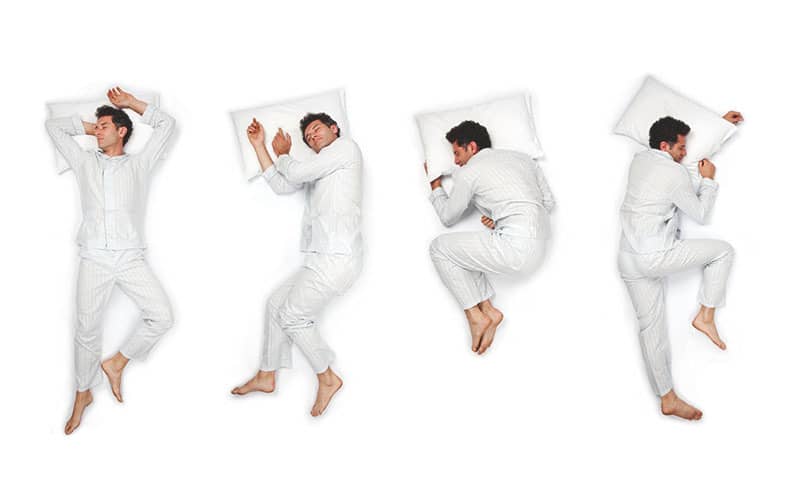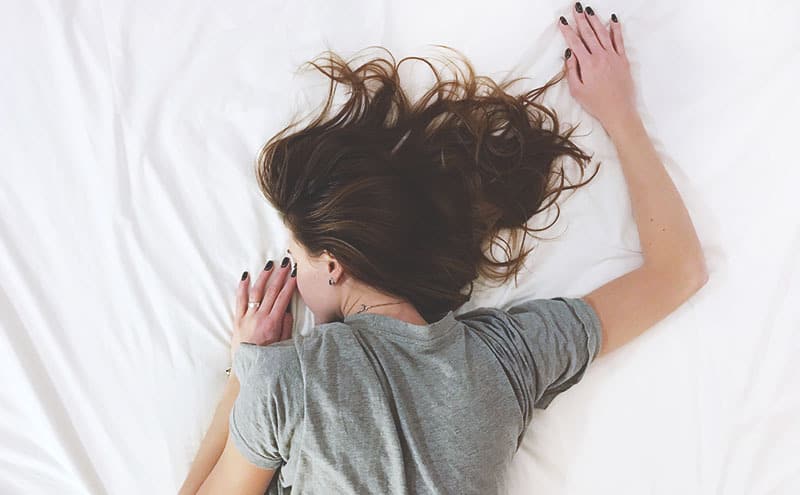
At a Glance
- People sleep in one or more of a number of different positions, and all have their advantages and disadvantages.
- Poor sleeping positions can affect posture, leading to pain, and also negatively affect the airways.
- It is difficult, though not impossible, to change your habitual sleeping position. We offer some practical tips if you want to achieve this.
When it comes to sleeping positions, we are all different. Whether you’re a side, front or back sleeper, we all seem to naturally gravitate towards particular positions. Some people remain in one position; others change at different points in the night.
A survey of one thousand people was conducted by Professor Chris Idzikowski, director of the Sleep Assessment and Advisory Service. It showed that seven percent of people usually sleep on their front; thirteen percent are back sleepers and 69 percent of people sleep in one of a number of side positions. The remaining people were unsure of their usual sleeping posture. (source)
Although some sleeping positions are thought to be better for health than others, there are pros and cons for each sleeping posture.
We take a closer look at what is the best position to sleep in, and the scientific evidence behind the theories regarding the best and worst.
Pros and Cons of Sleeping Positions
Contrary to popular belief, there is no one best position to suit everyone. Each different sleeping position has its own advantages and disadvantages, and it’s important to consider them all in relation to what’s best for you and your health needs. Here’s a rundown on the good and bad points for each sleeping position:
Front Sleepers
Many people consider this the worst sleeping position, but while it may be taxing for your posture, it has some benefits to the respiratory system:
Pros
- Minimizes airway obstructions
- Eases snoring
- Can ease sleep apnea
- Large area of body is in contact with the mattress; this helps distribute pressure evenly and avoids pressure points
Cons
- Neck and spine not aligned as head is turned to the side
- Flattens the natural curves of the spine; this can lead to low back pain
- Closer proximity of airways to allergens like dust and dust mites
- Increased risk of facial wrinkles (source)
About Front Sleeping
If you are at risk of or suffer from low back pain, try to change this sleeping position by trying some of our tips detailed below.
Use a thin pillow to help to keep a more neutral head and neck posture.
If you find that this isn’t possible for you, or you need the benefits of front sleeping, try putting a pillow under your lower abdomen and hip area to help maintain the natural curves of your spine.
Sleeping on your front is not recommended during pregnancy. While almost impossible in later stages, it should also be avoided in the early stages too, as it sandwiches the baby between your spine and mattress, and can provide less than optimum conditions for blood circulation. (source)
Back Sleepers
This sleeping position is generally considered to be the best, but it does have some good and bad points, according to research.
Pros
- Keeps the head, neck and spine in good alignment
- Helps to maintain natural lower spinal curvature
- Maximum contact with the mattress helps distribute pressure more evenly and avoids pressure points
- In combination with good pillow elevation, can reduce or prevent acid reflux
- Can help to reduce facial wrinkles (source)
Cons
- Makes airway obstruction more likely, especially in combination with too many pillows.
- Can make breathing more difficult
- Can make snoring worse
- Not recommended during pregnancy
About Back Sleeping
Sleep apnea is a condition that is characterized by pauses in breathing, or taking very shallow breaths while you sleep. It can result in an oxygen deficiency while sleeping.
As airway obstruction is more likely when sleeping on your back, it is not a position recommended for people with sleep apnea. In fact, some research has found that almost 54 percent of sleep apnea sufferers only have symptoms when sleeping on their back. (source)
Another point to consider is that a good sleeping position doesn’t always correlate to a good quality sleep experience. One study compared sleeping position with quality of sleep, and found that the people who reported poor sleep quality spent more time on their backs than in any other position. (source)
Sleeping on your back during pregnancy can increase low back pain due to the additional weight of the baby and amniotic fluid, which encourages flattening of your lower spinal curves. It can also cause decreased circulation due to the increased pressure of the abdomen. (source)
Side Sleepers
There is a great amount of variety when it comes to side sleeping; some people sleep on either their left or right, some curl into a fetal position, others sleep stretched out in a log position.
Left Side Sleepers
Pros
- Good position for digestion
- Can reduce or prevent acid reflux
- Can help to minimize airway obstruction
- Can reduce snoring
- Improves circulation
- Best position for pregnancy
Cons
- Can put extra pressure on the neck and jaw.
- Can result in left arm numbness
- May result in compression of the stomach and lungs due to gravity
- Body weight distributed over a relatively small area – may result in pressure points
Left side sleeping improves circulation to the heart. This is one reason why it is considered the best sleeping position during pregnancy, because it increases the flow of blood and nutrients to your baby through the placenta. In addition, it places less stress on your spine during pregnancy than other sleeping positions. (source)
In left side sleeping, gastric acids are thought to remain below the level of the junction between the esophagus and the stomach, reducing the likelihood of acid reflux. (source)
Right Side Sleepers
Pros
- Avoids pressure on the left lung, heart, liver and stomach
- Best position for digestion
- Can help to minimize airway obstruction
- Can help to reduce snoring
Cons
- May increase acid reflux
- Potentially not enough neck support
- Body weight distributed over a relatively small area – may result in pressure points
- Can put additional pressure on the neck and jaw
Scientific studies have shown that sleeping on the right side can increase acid reflux. In contrast to left side sleeping, the gastroesophageal junction is thought to lie below the level of gastric liquid when sleeping on the right side. (source)
About Side Sleeping
On the downside, one of the main problems of side sleeping in any position is where to comfortably put your arm. A common solution is to sleep with the arm nearest the mattress tucked up under the head.
Research indicates, however, that prolonged periods in this position can result in pressure on the blood vessels and nerves in the arm, constricting blood flow and eliciting pain and tingling from compressed nerves. In addition, this position puts an increased amount of pressure on the shoulder, which can result in shoulder pain. (source)
Keeping your hands down by your sides or tucked into your chest have both been found in research studies to reduce muscle activity in the neck and shoulders, and are thought to reduce the risk of neck and shoulder pain related to sleeping posture. (source)
Sleeping Upright
While this may sound a little strange to many people, there are certain circumstances when sleeping in an upright seated type position is beneficial.
People who have respiratory difficulties, including a heavy cold, sometimes use this position to help keep the airways as open as possible.
This position may also be used after suffering heart failure, or after some types of surgery to relieve pain and facilitate sleep.
The downsides of upright sleeping are that it puts pressure on your lower back, and may increase the likelihood of varicose veins. This is because the veins in the legs don’t get a rest from the effects of gravity if we spend much of our time in seated and upright positions.
Sleeping Position for Babies and Infants
According to research, babies and infants should always be positioned to sleep on their backs, on a firm mattress to reduce the risk of SIDS – sudden infant death syndrome. (source)
Other things to Consider
Whatever your chosen sleeping position, it is important to consider some other factors too.
Firstly, make sure that your mattress provides you with good support in conjunction with your sleeping position. Side sleepers, for example, need a mattress that is firm enough to produce good support, but with adequate padding to relieve the pressure at the major contact points, such as the shoulder, knee and hip areas.
Choosing the right level of pillow support is important, too. Back and front sleepers need to make sure they don’t elevate their head position too much
Side sleepers need to make sure they get adequate neck support, and take account of the hollow at the neck when side sleeping. They may also need extra support in the waist area. There are lots of different support pillows on the market that can help with this.
One home-made solution for the neck is to place a small, rolled-up towel inside the bottom edge of your pillowcase, underneath your pillow, so that it fills the neck hollow and provides increased support. (source)
How to Change Your Sleeping Position
Although we have very little control over what happens after we fall asleep, it is possible to modify your sleeping position.
Here are our top tips for retraining your body to sleep in a different position:
Practice
Practice makes perfect, and helps your body to become accustomed to a new sleeping position. When you have time to rest during waking hours, lie down on your bed in your chosen new position. The more you do this, the more likely you are to stay in this position for longer when you’re asleep.
Start as You Mean to Go On
When you first get into bed, assume your new sleeping position. Use your body to try to maintain this; positioning your legs slightly apart and leaving your arms in a suitable position away from the body can discourage you from turning over in the night.
Use Props to Help
Place pillows in strategic positions to help you maintain your new sleeping posture. For side sleeping, try putting pillows behind and in front of you to discourage you from rolling onto your back or your front. Placing a pillow between your knees, especially in back or side sleeping can help to reduce back strain and discourage changes in position while sleeping.
A rolled-up blanket can also be a useful tool to help keep you in place. Alternatively, body pillows, which are available in a regular rectangular or a curved shape, can help to provide additional support and help you to persuade your body to modify your sleeping position. Body pillows can be useful for front sleepers who want to change their regular sleeping position.
Regardless of the health benefits associated with any sleeping posture, people generally sleep in the position they find the most comfortable.
Experimenting with various different sleeping positions is highly unlikely to have any negative effects on health, so it’s fine to test out each of the different positions for a few nights and see which postures suit you best. There are advantages and disadvantages for every sleeping position.
What Is the Best Position to Sleep In? Final Thoughts
Whichever sleeping position people start their night’s sleep in – back, side, or stomach – people tend to wake up in the position that their bodies have a natural tendency to adopt.
Unless you have specific circumstances which dictate your sleeping position, if you are experiencing pain on waking from sleep or if you have been advised by a medical professional to change your sleeping position, it’s generally acceptable to let your body do what feels most natural.




Leave a comment